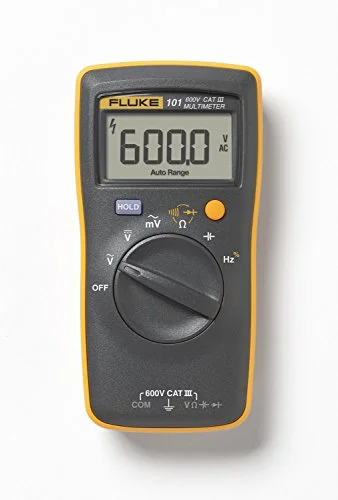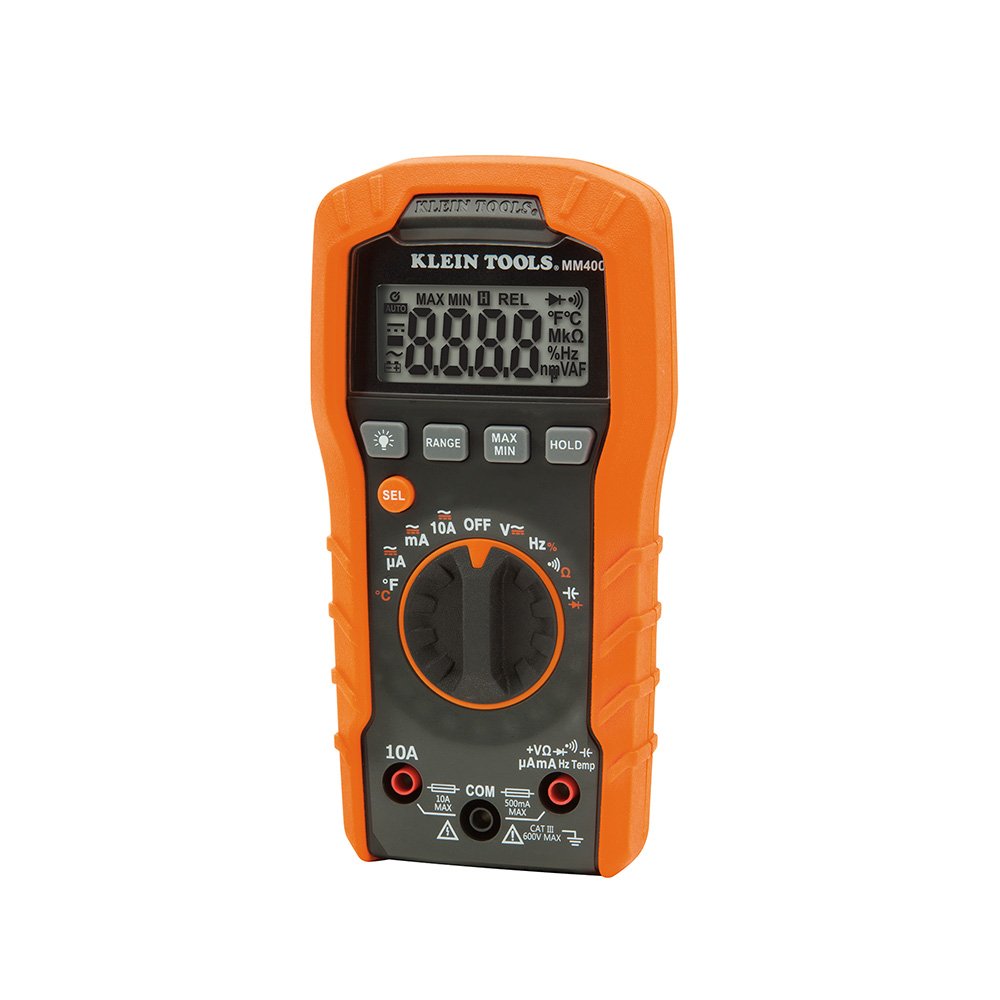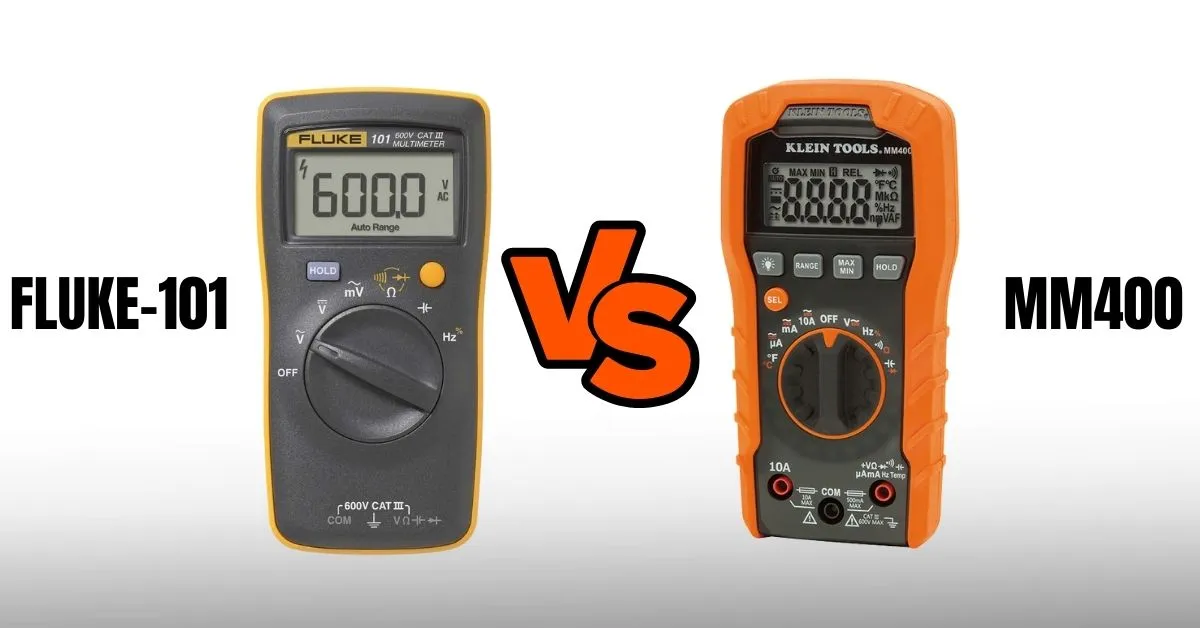No doubt about it, Klein and Fluke are big names in the multimeter game. These brands have built a solid reputation for their trustworthy and long-lasting designs.
Some folks get a bit confused between Fluke 101 vs Klein MM400, their most affordable offerings. While both deliver reliable performance, they do have some distinct differences that set them apart.
Now, let’s get one thing straight right off the bat. Fluke multimeters are the go-to choice for heavy-duty industrial use, while Klein multimeters shine when it comes to simple home testing and measurements.
So, let’s roll up our sleeves and take a closer look at each multimeter’s unique capabilities.
Which One to Consider?
Picking the right multimeter depends on what you’ll be using it for. The Fluke 101 is a tough and accurate workhorse, perfect for pros and heavy-duty tasks. The Klein MM400 is more budget-friendly, and ideal for everyday jobs around the house. Need a reliable tool for daily professional use? Go for the Fluke. Fixing things at home? The Klein is a great value option
Fluke 101 vs Klein MM400 – Specifications
| Feature | Fluke 101 | Klein MM400 |
|---|---|---|
| Display | 6000-count LCD | 4000-count LCD |
| True RMS | ❌ | ❌ |
| Voltage Range | 0.1mV – 600V | 0.1mV – 600V |
| Resistance Range | 0.1Ω – 40MΩ | 0.1Ω – 40MΩ |
| Capacitance Range | 1000μF | 1nF – 200μF |
| Frequency Range | 50Hz – 100kHz | 1Hz – 50KHz |
| Duty Cycle | ✔️ | ✔️ |
| Temperature Range | 0 °C to +40 °C | -18° – 538°C |
| Diode Test | ✔️ | ✔️ |
| Continuity Test | ✔️ | ✔️ |
| Low Battery Indication | ✔️ | ✔️ |
| Safety Ratings | CAT III 600V | CAT III 600V |
| Drop Protection | 3.3 ft (1m) | 3.3 ft (1m) |
| Auto-Range | ✔️ | ✔️ |
| Auto Shutoff | ✔️ | ✔️ |
| Price | $44-$45 | $54-$55 |
Fluke 101 – Quick Rundown
Fluke 101
- Basic dc accuracy 0.5%
- CAT III 600 V safety rated
- Diode & Continuity test (buzzer)
- Small, lightweight design for one-handed use
- Rugged, durable design
- Easy Battery Replacement
- Automatic Shutdown

The Fluke 101 is a small and light digital multimeter, often called a ‘traveler’s multimeter’ because it’s easy to carry around. It can measure voltage, resistance, continuity, capacitance, and frequency. However, it does not measure current.
Fluke 101 is notably compact—about half the size of the Klein MM400. 6000-count LCD display, but lacks a backlight. Offers auto-ranging on AC and DC volts, resistance, frequency, and duty cycle. Rated CAT III 600V, suitable for single-phase and three-phase installations on the load side.
Even though it’s made in China to keep costs down, it’s still made by Fluke, known for good quality. It’s the cheapest Fluke multimeter you can get, but it’s still a good value for the money.
The package for the Fluke 101 includes:
- Fluke 101 Multimeter
- TL75 test leads
- Two AAA batteries
REASONS TO BUY
- Small and lightweight design
- Excellent build quality
- Ideal for industrial use
- Reliable and accurate measurements
- A wide range of tests supported
- Separate voltage input ranges
- Affordable price point
REASONS TO AVOID
- Display lacks backlight
- Auto-ranging can be slightly slow
Klein MM400 – Quick Rundown
Klein MM400
- Measures up to 600V AC/DC voltage
- Electrical tester: temperature, capacitance, frequency, duty-cycle
- CAT III 600V safety rating
- Withstands a 3.3-foot (1 m) drop
- Low battery indicator
- Suitable for light-industrial locations

Read full Klein MM400 Review
Now let’s jump on Klein MM400, an auto-ranging multimeter designed by electricians for electricians.
The MM400 might not have all the fancy features, but it’s really good at doing its job well. It can test lots of things including measures temperature, frequency, capacitance, continuity, diodes, and duty cycle. While the capacitance range may not soar to the skies, capping at 200µF. It can measure up to 600V AC/DC voltage, up to 10 amps of current, and up to 40 Ohms of resistance.
The MM400 is designed smartly with a rubber cover that makes it easier to hold and can even survive a drop from three feet because of the rubber protection. The screen is big and easy to read (count of up to 4000), with a backlight for visibility in low-light conditions.
It includes a low battery indicator, a data hold function, and a Min/Max function to record signal variations. It comes with a CAT III 600V safety rating, suitable for various electrical setups.
Now, I won’t pretend that the MM400 can match the robustness of its higher-tier counterparts like the MM600 or MM700, but for its price point, it offers great value.
The package for the Klein MM400 includes:
- Klein MM400 multimeter
- AAA batteries (x2)
- Leads
- Thermocouple
- User manual
Pros
- Quality brand known for reliability
- Compact and user-friendly design
- Clear display with backlight
- Auto-ranging and micro-amps feature
- Comes with a thermocouple
Cons
- Not True RMS
- Not ideal for industrial use
REASONS TO BUY
- Quality brand known for reliability
- Compact and user-friendly design
- Clear display with backlight
- Auto-ranging and micro-amps feature
- Comes with a thermocouple
REASONS TO AVOID
- Not True RMS
- Not ideal for industrial use
What Users Say About Fluke 101 vs Klein MM400
Let’s hear what users have to say about the Fluke 101 and the Klein MM400.
Regarding the Fluke 101, one user who rebuilds old vacuum tube volt meters raves about its performance. They regularly use it to calibrate and troubleshoot circuits in 50-60-year-old technology. After almost a year of consistent use, they haven’t had to change the batteries yet. The auto shut-off feature gives them peace of mind. Right out of the box, the resistance and voltage measurements were spot on. The only downside they mention is the lack of a kickstand, likely due to the leads coming out the bottom. However, they found a .stl file to 3D print a plastic base if needed. They also suggest that a rubber over-molded sleeve would be a nice aftermarket addition, in case the multimeter gets dropped.
On the other hand, let’s dive into a user’s experience with the Klein MM400. Initially, they had a negative encounter, but the way Klein Tools handled it turned their experience around. They reached out to Klein Tools through Amazon Customer Service, and Klein Tools promptly resolved the issue. Not only did they refund the full amount, but they also told the user to keep the product! The user greatly appreciated this excellent service and upgraded their rating from 1 star to a glowing 5-star review. However, they also noted some dissatisfaction with the packaging, which seemed to indicate it was a used or returned item. Additionally, the test leads were missing, which was a crucial part of the product. They expressed frustration but couldn’t recall if they had chosen the “Used – Good Condition” or “NEW” option when purchasing. Overall, they were looking forward to the product but were disappointed with its initial condition.
These real-life experiences give us insights into the Fluke 101 and the Klein MM400. Remember, individual experiences may vary, so it’s important to consider multiple perspectives before making your decision.
Final Verdict – Fluke 101 vs Klein MM400
After exploring the features, customer reviews, and overall performance of the Fluke 101 and the Klein MM400, it’s time to reach a final verdict.
When it comes to overall superiority, Fluke 101 emerges as the winner. Its reliability, accuracy, and the added bonus of a lifetime warranty make it a top choice for professionals and enthusiasts alike. The trustworthiness of the Fluke brand, coupled with its precise measurements, sets it apart from the competition.
However, let’s not dismiss the Klein MM400 just yet. While it may not have all the bells and whistles of the Fluke 101, its compact size, ease of use, and dependable performance make it a worthy contender. For those seeking a straightforward multimeter that gets the job done without any fuss, the MM400 proves to be a reliable companion.
In the end, the final verdict leans in favor of Fluke 101.



